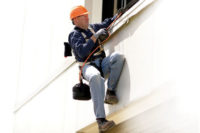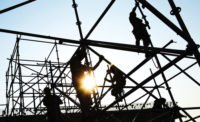Cover Story
7 parts of an in-house rescue plan for working at heights

Photo credit: Getty Images
Employees who work at height face the perilous danger of falling.
A personal fall arrest system can provide protection to eliminate or mitigate the possibility of creating a situation that leads to a condition known as suspension trauma or orthostatic intolerance.
Preventing this situation is why a fall rescue plan is critical. To prepare employees for a rescue scenario, many organizations are developing in-house rescue policies and procedures.
A peer-reviewed article by Rick Argudin, CSP, a senior training specialist at 3M, titled “Rescue Planning: Safety Recommendations for Organizational Rescue Teams,” offers a framework for building an in-house safety plan.
A good plan includes these components:
- Preparation and inspection of all gear
- Leader/team roles assigned and practiced
- All hazards identified and controlled
- Nothing left to chance
While such a plan should be comprehensive, it shouldn’t be complex. “The goal of a rescue initiative should be to keep the process simple and safe,” Argudin says.
He identifies seven essential components that an organization should include in its in-house rescue plan.
1. Achieve organizational commitment
The best rescue plan for employees working at height is one that has the organization’s full support. To earn corporate buy-in, Argudin recommends that rescue plan achieve the following:
Reduce costs and improve productivity. Business leaders are always looking to make operations more efficient, cost-effective and prosperous, Argudin says. Safety supports these initiatives. Falls are costly and include “direct and hidden costs such as time lost by workers not injured; overtime work or other activities necessitated by the incident; decreased output of the injured worker; and new worker learning period.”
Ensure compliance with regulations. OSHA regulations require rescue plans and ANSI/ASSP Z359.4 provides key guidance as well. According to OSHA, employers must provide for “prompt rescue of employees in the event of a fall or shall assure that employees are able to rescue themselves.”
2. Include incident response planning
Once an organization recognizes the importance of planning, the next step is to effectively prepare for unforeseen incidents. That’s why planning for a coordinated response to falls from height is a best practice. “The objective is to always be ahead of the curve,” Argudin writes.
He recommends a “complete, comprehensive analysis of hazards” that reviews both “preincident and postincident conditions to create the best plan of action.” Procedures for emergency responses must be documented in operational incident response plans.
3. Ensure the safety and compatibility of operational equipment
When organizations are selecting and using equipment in their rescue plans, they need to consider several elements related to the safety of the worker who fell and those performing the rescue.
Ensure simplicity and compliance with performance testing standards. This is a key consideration when selecting equipment to incorporate into incident response planning.
Conduct a feasibility analysis of the equipment needed. Additionally, an organization should base equipment selection on a thorough review of the potential location of the rescue, anticipated conditions and possible limitations for use.
Make sure rescue systems are readily available, in operational condition and accessible to trained individuals. Using a comprehensive inspection and readiness evaluation process is an effective way to accomplish this.
4. Training is key
“No amount of planning or equipment purchases can substitute the importance of a comprehensive and engaged training program,” Argudin writes.
According to the ANSI/ASSP Z359 series of fall protection/restraint voluntary consensus standards, a comprehensive rescue training course should include instructional guidance, performance assessments, identification of fall hazards and methods of safely releasing rescue subjects from fall arrest systems. Argudin offers these tips for creating an effective training program.
- Focus training on performance-based exercises that help rescue team members develop confidence.
- Use real-world examples of rescue scenarios to engage trainees in a “real-time” execution of various crisis situations.
- Use repetition and periodic drills to help team members practice key skills and recognize potential obstacles they may encounter.
- Emphasize the need to adapt, improvise and adjust during a rescue operation.
- Reevaluate training programs annually.
5. Develop relationships with local first responders to create mutual aid agreements
Your organization should inform local first responders of the in-house plan, but they can also play an active role in a rescue, according to Argudin. They can arrive on scene and serve as backup should the rescue team encounter any issues or support the next step in the command structure by providing medical aid.
By establishing a working relationship with local municipalities (e.g., fire, emergency medical services), you can accomplish several goals: All parties involved have a copy of the plan, direct communication channels are clarified and disruptions to the incident command structure are eliminated.
“No matter what the actual roles are, the benefits of coordinated efforts far outweigh not having an agreement,” Argudin explains.
6. Establish a written rescue plan
To develop rescue procedures, Argudin recommends “training using a hierarchy approach to rescue, a thought process designed to systematically provide the planner with safe options based on the postfall environment.” This includes:
- Self-rescue
- Mechanically aided rescue
- Rescuer-assisted systems
- A rescuer-descending pick-off technique
When following this order, you implement simple solutions first and progressively increase the complexity, he says. By selecting pre-engineered systems, you can substitute some technical aspects of high-angle rescue with user-friendly options.
7. Additional rescue safety considerations
“Any work performed at height should have safety as its primary concern,” Argudin writes.
During a rescue, you can achieve this by designating a trained person who can identify the resources necessary to conduct a safe, effective rescue from heights and verify that those resources are available for a prompt rescue. Such an individual should:
Have comprehensive knowledge of incident hazards, applicable regulations and standards, the company rescue plan and recognized safety practices and risk management criteria, including what constitutes unacceptable levels of risk.
Be responsible for performing or assisting in workplace rescues; verifying that a rescue procedure has been developed; inspecting the rescue equipment prior to a rescue event; and be trained to recognize local fall hazards that may endanger the rescuer during rescue operations.
Consider medical issues in accordance with regulatory requirements.
With these seven essential parts included in your in-house rescue plan, combined with appropriate fall protection, your organization can safeguard employees working at height.
Looking for a reprint of this article?
From high-res PDFs to custom plaques, order your copy today!








